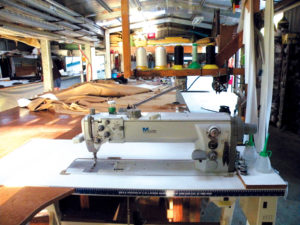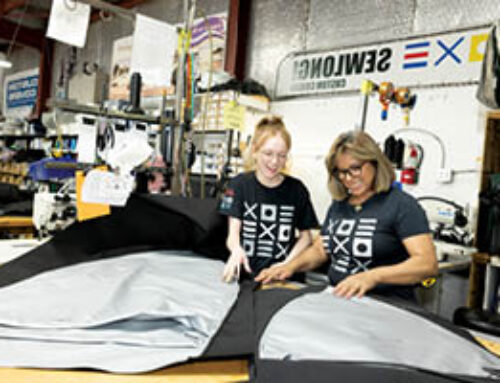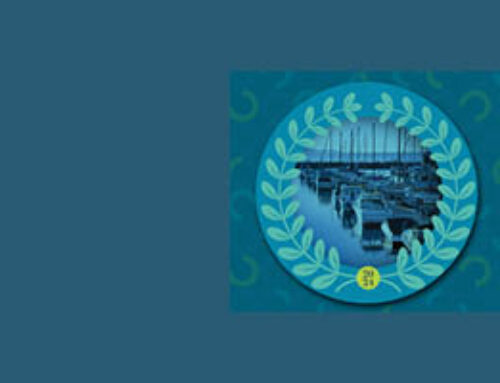Eye of the needle
Bread and butter. Life blood. Members of the family. Call them what you will, industrial sewing machines are fabricators’ best friends—or, perhaps on a bad day, their worst enemies.
Fabricators, manufacturers and suppliers tell us what’s new and what’s still working. Opinions abound about lubricants and thread and buying used machines. They share invaluable advice and techniques on how to keep these best friends happy and long-lived. And how machines can make your shop more efficient and marketable
What’s new in sewing machinery?
Innovation and functionality are key. “Industrial sewing machines,” says Frank Henderson, CEO of Henderson Sewing Machine Co. of Andalusia, Ala., “continue to improve in quality, ease of operation and functionality. The digital revolution is accelerating innovation in the design of sewing machines with imbedded servo motor controls, higher arm working space, longer bed working space and more functional operator options.”
“The main changes have come from the area of automation for large-scale manufacturing facilities and with improvements to machine motors,” adds Art Garabedian, national sales manager of Reliable Corp., based in Toronto, Ontario. “For example, the SewQuiet clutchless DC servo motor was introduced about seven years ago. The servo motor has evolved over the years to reduce noise, allow step stitching and, soon, needle-positioning synchronization.”
Doug Glenn, vice president of sales for Consew of Carlstadt, N.J., concurs. “Servo motors are now affordable,” he says. “Unlike conventional clutch motors, the new servo motors will help by using 70 percent less electricity. They have a needle positioner (up and down); adjustable top speed; and variable speed control, including a soft start. They’re easy to install, and first-time sewers can sew like pros.”
Consew also provides LED lights in their sewing machines. “No heat, and they’re inexpensive. They last a lifetime, [use] a small amount of electricity, they’re bright like sunlight and easy to install. They last forever. A must-have,” Glenn says.
“New machines are more user-friendly, providing large bobbins to help avoid frequent stops,” says Robert Kotowski, vice president at Lake Shore Boat Top Co. of Detroit, Mich. “They also have easy thread-length gauges on them to change your stitch length on the spot.”
Holding it all together
Brian Bennett, MFC, of Noank, Conn.’s Custom Marine Canvas, reports on what is new in his shop. “We have primarily used single straight-stitch machines for the majority of our work. We have an older Singer 107 zigzag that we use when sewing light-gauge sail materials. We also have a Juki serger that is used in interior and upholstery work. We just purchased a Consew 199RB. This machine is similar to a zigzag machine, but it sews a pattern of three stitches in one direction and then three stitches in the other direction. This expanded zigzag format allows us to sew lap-seams in a single pass, instead of the usual double pass. This is a real time saver for joining large panels of cloth.
Glenn says he’s seen big changes in thread. “PTFE has a really long lifespan. And Fil-tec’s Aquaseal, when wet, will expand 14 times its size to make the seam waterproof. We’re seeing fabricators using needles with titanium coating, diamond point, leather point, ball point and many more—especially with our decorative stitch machine.”
“Think of thread as your business card,” says Kotowski. “Gore Tenara thread is one of the best threads on the market and comes with a lifetime warranty. Yes, this thread is expensive, but by using this product, you will get repeat and referral business.”
And how long should a sewing machine last? “Forever,” says Glenn, “provided you can get parts.”

Advances in technology are more likely than usage to render a well-maintained sewing machine “obsolete”.
Henderson elaborates. “Industrial sewing machines are precision manufactured to operate for 20 to 30 years under normal operating conditions [and] with proper maintenance. However, most equipment will become technologically outdated before it is operationally outdated. Do you drive the same automobile today as you drove 20 to 30 years ago? Industrial sewing machines should be viewed as a tool. Therefore, maintain your equipment to maximize its life. But, always be aware that it helps you make a living. Can you be productive and efficient with an ‘antique’?”
A little maintenance goes a long way, says Bennett. “We usually get at least 10 years or longer out of our machines. Just adjust and replace parts when they need it, and they will last a very long time.”
Speaking of maintenance, manufacturers have different insights.
“Sewing machines should be kept clean and oiled every day,” says Henderson. “Maintaining sewing machines with the correct mechanical adjustments is essential to a productive sewing process. The machine should be adjusted correctly by a highly trained and skilled industrial sewing machine technician. Sewing needles should be changed every 50,000 to 100,000 stitches to ensure proper stitching of your product. Sewing needles are heat-treated steel material that wears with usage.”
Garabedian says, “Maintenance is really simple. Oil once a month and remove any lint buildup. Parts that most often need replacing [because of] regular wear and tear are relatively inexpensive; i.e., needle plate, feed dog, bobbin case and bobbins.”
Glenn concurs that set-up and maintenance are essential. “Very little maintenance is necessary if the machines are set up properly by a manufacturer’s technician or by a sewing machine dealer. The most common problems with sewing machines are 1) the machine is not threaded correctly or 2) the needle is put in backward or 3) operator error. Avoid these and you’re doing well.”
Something old, something new
Deciding when to buy new and how to make the most of what you have will depend on budget, need and philosophy.
Several factors affect the decision to buy a new machine versus repairing an old one, suggests Kotowski. “When the repair cost could be very expensive—maybe a third to half the price of a new machine—making the decision to buy new is a little easier,” he says. “Another question you have to ask yourself is, did the machine serve its purpose and was the return on investment met and/or exceeded for the original purchase?
“Depending on your shop and size of your company, purchasing used machines might be the only route for you,” he adds. “Even if you have the means to buy new, purchasing a used machine to see how it works and if it will meet your demands might be an affordable testing method. If the machine doesn’t work for your shop, you can resell it for almost the same amount and move on to find the right machine.”
“We are not afraid to take on a used machine if it looks like it has been maintained and not beaten up or abused,” says Bennett.
On the other hand, Consew’s Glenn notes, “Does it make sense to acquire used equipment? No. The price of new equipment is a mere 20 to 30 percent more, and with new machines you get a warranty. When you buy a used machine, it’s like buying a used car with no odometer reading—you just don’t know how many miles there are. You may need to buy a new shuttle hook and other parts that will totally negate any savings that you may have had by buying used.”
“When I first started out in business, I figured a new machine was beyond my budget,” says Darren Arthur at Nautilux Custom Canvas in Hazlet, N.J. “So I bought a used one from a dealer. When the time came to buy another machine, I debated new or used. The price of the new one was, say, $1,800 and a used one, $1,200. I figure it’s like buying a car or anything else you want to keep for a long time: invest up front. With the new machine I had a warranty and a way to get in touch with the dealer.”
Dave Elliott, owner of David’s Custom Trimmers in Brisbane, Australia, is hanging onto a relic.
“My first machine was a second-hand Consew, and I used it for 20 years and still have it,” he says. “The lifespan depends on how well you look after it—regular cleaning and oiling gives an infinite life. Every time I put a bobbin in the machine, I drip oil on it and seem to have no maintenance problems. I have not needed a mechanic for 15 years.
“We oil up the machines on Friday, and then give them a quick wipe down so they’re ready for work on Monday. I also remove the shuttle case occasionally and clean behind.”
He’s a big fan of Dercop’s Adler machine, which features a single oiling point. “It has a dial on top to adjust the walking height to ride over high/thick materials, and long arms that suit all different applications, an LED light above/near the needles. Adler have a new range with a huge bobbin and a servo motor built in. I have used Teflon thread for all exterior applications for the past 17 years and run the thread through silicon oil lubricators and this helps with wear and tear on the machine as the Teflon thread is harsh without lubricant.”
Efficiency and marketability
Being an efficient Johnny- or Jane-on-the-spot can build your marketability. “There is opportunity to expand marine fabrication business models by adding on-site marine upholstery and sail repairs to a list of services,” says Art Garabedian. He cites the use of Reliable’s Barracuda, a portable walking-foot machine. “There’s a handwheel kit available that can be used when you need to do repairs on-site that are ‘off the grid,’” Garabedian says.
“We have areas set up for specific jobs,” says Kotowski. “In our upholstery division, a Singer 111 is used only to do upholstery work. Also, we have one machine set up specifically for canvas and upholstery repairs. This is a huge market for our business: providing timely and affordable canvas repairs to help customers get one more season out of their existing canvas. All repairs are done on this designated machine and never on a machine we use for finished products. Having the correct equipment in our facility helps our employees be more productive,” Kotowski says.
Dara Syrkin is a freelance writer from Minneapolis, Minn.
 TEXTILES.ORG
TEXTILES.ORG 






